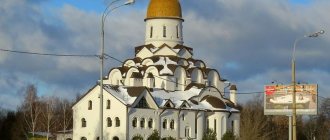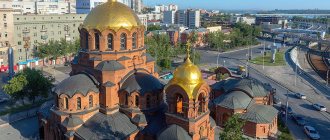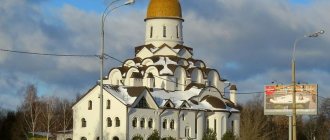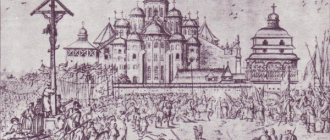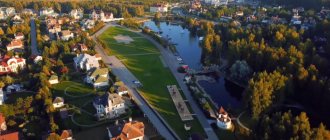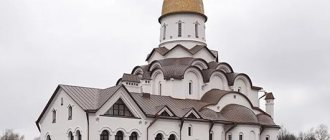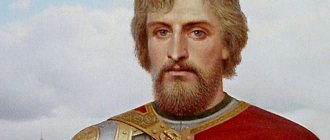The Cathedral named after Prince Alexander Nevsky has long been part of the main tourist routes in Nizhny Novgorod. It is considered the highest in the city and the third in Russia, after the Cathedral of Christ the Savior in Moscow and St. Isaac's Cathedral in St. Petersburg.
The height of the New Fair Alexander Nevsky Cathedral is 87 meters.
It received its name “Novoyarmorochny” thanks to the annual fairs that took place not far from here. The construction was initiated by the merchants, and the site for the foundation of the cathedral was chosen by Emperor Alexander II, who visited Nizhny Novgorod in 1858. It became the arrow of the two rivers Volga and Oka.
© Vladimir Shefer
History of the temple
The appearance of the temple was determined by the visit of Emperor Alexander II to the city fair. Before this, a small temple was planned, but after the sovereign’s visit, a decision was made to build a grandiose structure.
Alexander Nevsky Cathedral in Nizhny Novgorod
The majestic temple dates back to the middle of the 19th century. In 1856, the merchants who brought their goods to the fair decided to build a temple in the city, timing the construction to coincide with the visit of this fair by the tsar himself. They addressed this question to the ruling bishop, and he addressed the governor. The land administration and local authorities were not against the construction of the temple, but significant funding was required. The money was collected for 10 years, and the required amount was only available in 1866.
A number of obstacles arose during the development and approval of the project. The first project was rejected because it did not inspire confidence in terms of strength. Then financial difficulties reappeared. After a number of adjustments, the project was accepted, and construction began in 1868. The main work took 13 years, and finishing work continued until 1881. The result of many years of work was an 80-meter magnificent cathedral, rising at the picturesque confluence of two rivers - the Volka and the Oka. The construction site was indicated on the arrow by the emperor.
The new temple was solemnly consecrated in 1881. Emperor Alexander III himself and his family were present. The temple was distinguished by the fact that it did not have a specific parish. Its parishioners were visiting merchants, and important guests of the city were often greeted in the building.
Archival photo of the temple complex
After the revolution, years of struggle against religion began, and in 1929 it was decided to close the temple and confiscate its valuables. In the winter of 1930, the Volga Flotilla was ordered to remove all the temple decorations made of wood and use them as firewood for home stoves. Thanks to the personal sacrifice of some local residents, several shrines were saved. During the same period, the building was used by the Bolsheviks as a residential building, and they also organized a warehouse there. Several rooms were added. In the 40s, as a result of a fire, the painting was badly damaged. During the Second World War, an anti-aircraft gun was raised onto a light drum.
The restoration of the monastery began in 1983, and was carried out only thanks to the work of volunteer restorers. The cathedral was transferred into the possession of the church only in 1992. Three chapels were consecrated in it in turn.
The first liturgy after a long break was served in the church in 2009, at which time the cathedral became a cathedral.
North wall
North wall.
Construction of temples by Prince Alexander (left). Prince Alexander judges people (right).
Fragment of the Northern Wall...
Expulsion of papal legates (left). Return of captured Russians from the Germans (right).
Architectural ensemble of the cathedral
It is impossible to describe in one word the style in which the cathedral is made. Despite the fact that this is a very large building with massive faceted tents, it is quite harmonious and does not feel heavy. The architect of the cathedral was L.V. Dal, the son of the creator of the famous explanatory dictionary. The project became possible after a painstaking study of the local soil and prediction of shrinkage. The temple does not have a traditional foundation in the form of piles. It is a solid slab folded on a wooden raft, which became its base.
The tents were erected using metal structures and frames. The building has a square plan, five tents, with one vestibule projecting to the west. The height from the floor inside the room to the main dome is 44.5 m. The large room of the temple was initially opened for worshipers only in the summer, when the fair was open.
The height of the monastery was 87 m in the 19th century. made it third on the list of the tallest churches in Russia. The cathedral takes its place after the Cathedral of Christ the Savior and St. Isaac's Cathedral.
Belfry near the Alexander Nevsky Cathedral
Construction
The structure was developed in St. Petersburg by several engineers, but, unfortunately, the author of the final project has not been identified, it is only known that it was finalized by the young L.V. Dahlem. The building shows the Russian-Byzantine style that dominated the country at the time of its construction.
Alexander Nevsky New Fair Cathedral represents a combination of several architectural trends. According to the structure of the monastery, it resembles the so-called Greek cross. The temple is endowed with octagonal tents, the most central of which rises up to as much as 73 m. The entire structure rises 87 m above the ground.
The construction of such a magnificent structure lasted thirteen years. After finishing the internal work, the temple was opened in 1882.
Exterior decoration of the cathedral
Initially the building was unplastered. It was made of red brick with white traced rustications. The tents were painted with checkerboard. The main decorations of the cathedral are high tents crowned with shining domes, faceted drums, and intricate cornices. Currently the walls are plastered and painted with ocher. This allowed us to achieve a more cohesive and restrained appearance of the building.
It is interesting that the giant bell of the monastery, which weighs 60 tons, was cast for several hours in a row, and it took three weeks to cool down.
Iconostasis
Fragment of the Iconostasis.
View of the Iconostasis from the center.
Fragment of the Iconostasis.
View of the Iconostasis from the left side.
View of the Iconostasis under the central chandelier.
Fragment of the Iconostasis.
Interior decoration
Modern masters have not been able to understand how in the 19th century. a 23-meter iconostasis was installed, because this is the height of an eight-story building.
For the interior decoration of the cathedral, ancient images were used, brought here from the Makaryevsky Monastery damaged by the fire. Many new icons were created by the icon painter F. Sokolov.
In the XIX century. the cathedral had a beautiful iconostasis, the height of which reached 23 m. After destruction by the Bolsheviks, modern masters were unable to completely recreate it, so the current iconostasis is the result of the works of our contemporaries. The lost painting was restored by modern masters, who during their work relied on the little information about the cathedral, as well as photographs that have survived to this day.
Ancient images were used for the interior decoration of the cathedral
Mariinsky chapel
Mariinsky chapel.
Fragment of the dome.
Fragment of a painting in honor of Mary Magdalene.
Altar part.
Shrines and relics of the temple
After the closure and looting of the temple by the Bolsheviks, many shrines stored here were lost. Since the cathedral was returned to the church and began to be restored, many revered icons and pieces of holy relics have arrived here. Pilgrims can venerate the relics:
- fourteen Russian saints;
- ten elders from Optina Hermitage;
- Vmch. Panteleimon;
- St. Euthymius of Suzdal;
- St. John of Damascus;
- St. Macarius of Zheltovodsky;
- right Alexy Bortsurmansky;
- St. Seraphim of Sarov.
In addition to arks, holy relics can be placed in special reliquaries on images of saints. For example, the church contains icons of Solovetsky and Nizhny Novgorod saints with parts of their relics. The image of the prince is especially revered. Alexander Nevsky with a particle of his relics.
All-Merciful Savior
Belt of the Blessed Virgin Mary
Cancer with the relics of St. right warrior Feodor Ushakov
South Apse
South Apse.
Sending the youth Alexander to study.
The youth Alexander is learning military skills.
The installation of the youth Alexander as prince of Novgorod.
The bishop's blessing to Prince Alexander for the battle with the Swedes.
Images of Euphrosyne Staritskaya and Sofia Slutskaya.
From left to right: Dmitry Donskoy, Daniil Moskovsky, Andrey Bogolyubsky, Dmitry Uglichesky, Dovmont Pskovsky.
Information for visitors
Tourist groups and pilgrims from other cities can take part in excursions that take place at 12:00–18:00. Preliminary coordination of excursions is possible by calling: 245-24-85. Detailed information about the life of the temple is presented on its official website: https://nevskiy-nne.ru/.
Schedule of services
The temple is open to Orthodox Christians daily from 8:00 to 19:00. Services are held every day. Liturgy begins at 9:00. Before the service begins, parishioners can make confession. Prayers are served at 8:30. On Sundays, two liturgies are celebrated - at 6:00 and 9:00. Evening services on the eve of each liturgy begin at 17:00.
Patronal holidays
Due to the fact that the temple is a cathedral, the thrones are celebrated several times a year:
- December 6 and September 12 – blgv. book Alexander Nevsky;
- August 4 – Equal. Mary Magdalene;
- December 19 and May 22 – St. Nicholas the Wonderworker;
- August 7 – St. Macarius of Zheltovodsky.
The temple is open to Orthodox Christians every day
Cathedral address and how to get there
The cathedral is located at the address: Nizhny Novgorod, Kanavinsky district, st. Strelka, 3A. Near it there is a river port. By public transport you need to get to the “Strelka” stop, and from there walk about 700 m. To get to “Strelka”:
- buses No. 3, 19, 26;
- minibuses No. 18, 50, 70;
- metro (on the blue line).
Rules for visiting the temple
Within the walls of the temple there is a church shop, an educational department, a workshop for restorers, and in the refectory, pilgrims are treated to tea and pies.
When visiting the cathedral, as well as when visiting any other Orthodox church or chapel, you need to adhere to a number of simple rules:
- You should have a decent appearance without exposing your body. You cannot enter the temple in shorts or T-shirts. Women must have their heads covered. Men are prohibited from wearing any kind of headdress in the temple.
- You cannot make noise, be a hindrance to prayer and services, or walk around the church arbitrarily.
- You cannot enter the temple under the influence of alcohol or drugs, or bring in alcoholic beverages or meat products.
- Before entering the temple, you must turn off your mobile phones or switch them to silent mode.
Visiting the temple is free for tourists and pilgrims. Any donations will be accepted with gratitude and prayer.
Author's advice
The construction of a monumental cathedral in Nizhny Novgorod is closely connected with the royal family. For many years, the majestic building enjoyed due respect and veneration, but after the revolution, the temple suffered, like many Orthodox monasteries during that period. Currently, the cathedral has been completely restored, services are held there, and the monastery warmly welcomes pilgrims and parishioners.
If you find an error, please select a piece of text and press Ctrl+Enter.
How to get there by public transport
The temple, located in the historical part of the city, can be easily reached by any type of public transport, and then walk a short distance towards the visible cathedral.
| Kind of transport | No. of routes | Stop name |
| Bus | 3, 19, 26, 41, 43, 52, 61, 90 | "Strelka" on Sovetskaya Street |
| Minibus taxi | 18, 50, 70, 87, 91, 92, a-71, t-37, t-40, t-41, t-42, t-45, t-47, t-57, t-90 | "Arrow" |
| Metro | Blue line of the underground metro line | Strelka station |
You can take a taxi, which can easily take you directly to the cathedral square or anywhere in the city.
